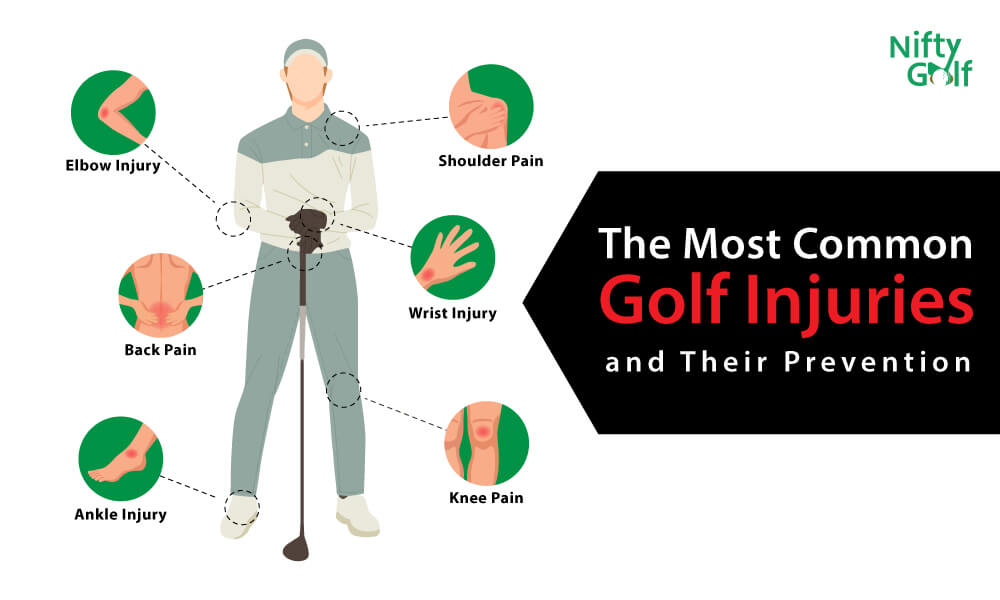Only an expert golfer knows how much effort, skill, willpower, and perseverance it takes to excel in the game. The swings are naturally energy deteriorating. They require a great deal of force from the players. They put an excessive amount of pressure and stress on players’ bodies. Therefore, professional golfers often fall into injuries. Players must learn about the most common golf injuries to avoid and prevent different types of injuries. By taking certain measures, golfers can even sustain injuries and keep playing. Let’s start by learning about the most frequent golf injuries.
Most Common Golf Injuries and Their Prevention
If you analyze how a golf player moves different body parts, you will understand why the most common golf injuries occur in the lower back and different joints. Here are the most common injuries golf players tend to fall into:
1. Golf Back Injuries / Back Pain
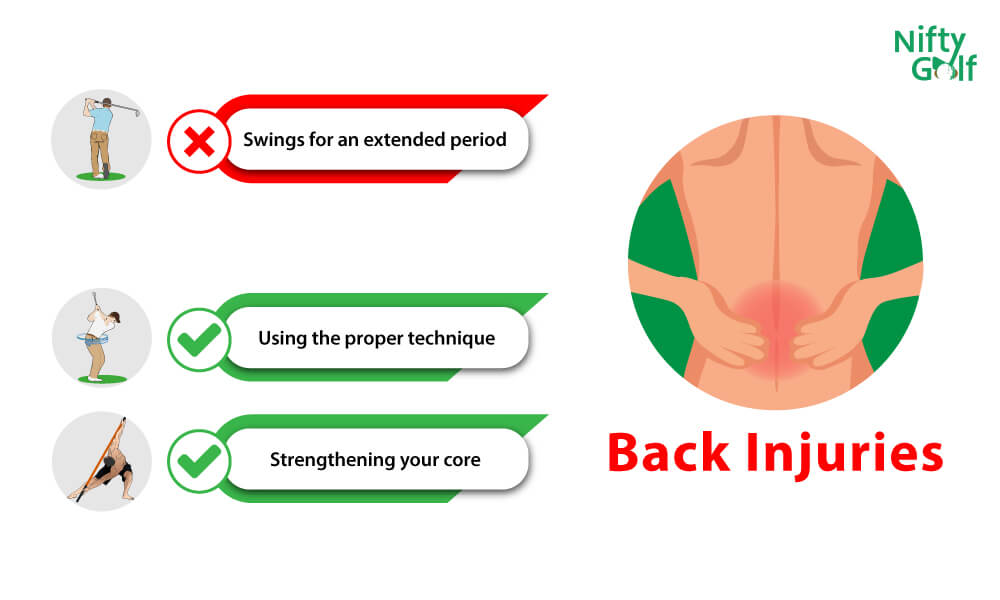
Golf is not easy to play. Every expert and amateur will agree with this fact. When you make swings for an extended period, as you always have to, the repeated stress originated from the rotations creates severe back pain. Statistics show that about 25% of golf injuries are related to back pain. And the more aged you are, the greater your chance of getting a backache.
Prevention: Using the proper technique is the best solution for such pain. You can also ensure that your back is limbering by specific exercises. Planks, hip cross-overs, and slow sit-ups can strengthen your core. Strengthening your core will be highly effective for your back pain.
2. Golfer’s Elbow

Golfer’s Elbow is more like an inter-gaming term. The medical term for the injury is medial epicondylitis. If you ever get injured by this, you will likely feel soreness and inflammation in your forearm because of the sore tendons and muscles.
The forearm muscle helps a golf player grip, flex, and rotate the arm and wrist. That’s why golfers use these muscles the most and fall into injury.
Prevention: While learning the game, you should consider learning from professionals. Veteran mentors teach every step and stand of the game in the right way. Therefore, you will learn the right fitness and body language rules to prevent injuries like Golfer’s Elbow. You can also consider using a compression strap for your elbows. It will keep the extensor muscle in your wrist from contracting dangerously. Thus, it will save your elbow from straining.
3. Golf Knee Pain / Knee Injury
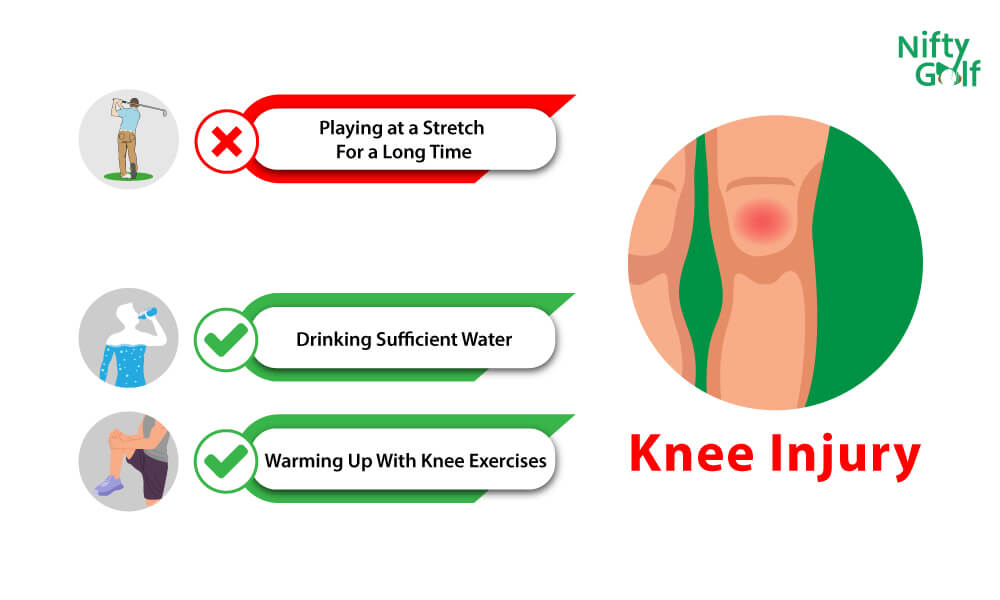
Only 10% of golf injuries are related to knee pain. Still, the significance of the injury is the reason for its presence in this most common golf injury list. Usually, knee pain induces for three reasons:
Prior knee condition: If you have an already injured knee and struggle to manage the hip axis rotation while playing a swing, it can get you into a potential knee injury. Arthritis patients happen to have knee pain. So, such patients can also suffer a knee injury while playing golf.
Wounded soft tissue: Knee joints can’t absorb extreme force. Sudden strikes or stress can tear ligaments, cartilage, and soft tissues around the knee area. A twisting motion during a swing can harm delicate tissues and originate pain.
Overwork: Knee injuries can also occur due to swing mechanics and overuse. A good warmup session and good body mechanics can help you keep such injuries away.
Prevention: Staying hydrated can loosen the muscles and ligaments. It will make them more tenacious and raise their ability to absorb more stress. Besides, warming up the knee before hitting a golf course will also help you avoid knee injuries.
4. Golf Wrist Injury
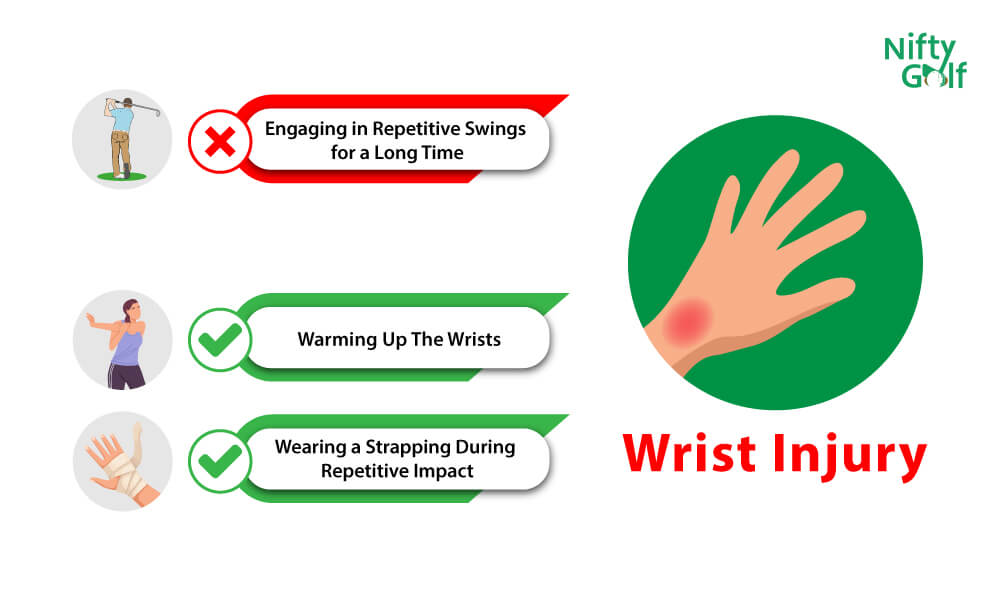
Wrist injury is another common injury in golf. In most cases, wrist injuries refer to just nominal or intensive pain. However, serious injury can also happen from the club’s impact with the ball or the lower ground.
Typically, the impact that comes from a few swings will not harm you. But your wrist can’t tolerate stress when someone plays excessively or uses his hands for repetitive swings. The most common wrist injury for a golfer is golf wrist tendonitis. It swells the tendons of the wrist and hampers wrist movement.
Prevention: A little wrist warmup, like stretching, will come in handy to avoid wrist and hand injury golf. You can also wear strapping on your wrists to prevent or limit the severity of injuries from repetitive impact.
5. Golf Ankle Injury
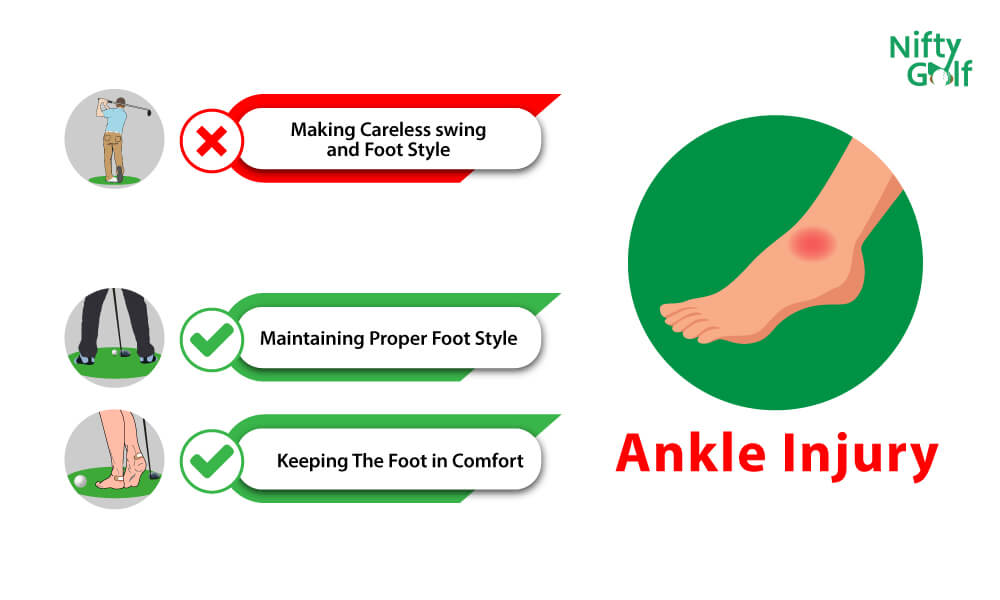
During a golf swing, a player’s body works like a whip. Like the whip, the body gets its power from its root spot, its legs. There are definitive rules on the position and style of the feet for making an ideal swing. Infringing these rules and putting repetitive pressure on the feet can cause injuries like ankle tendonitis. It is one of the most severe and common golf injuries.
Other than this, strains, sprains, and inflammation in the ankles and feet are also among the worst golf injuries. Since some players tend to walk the full course, they also get a negative impact on such pains and injuries.
Prevention: You should ensure that your feet are in comfort. You need to give your feet some rest during the game. Shoes that properly fit the feet are made with comfortable elements that can provide protection and comfort to the ankles.
6. Sunburn
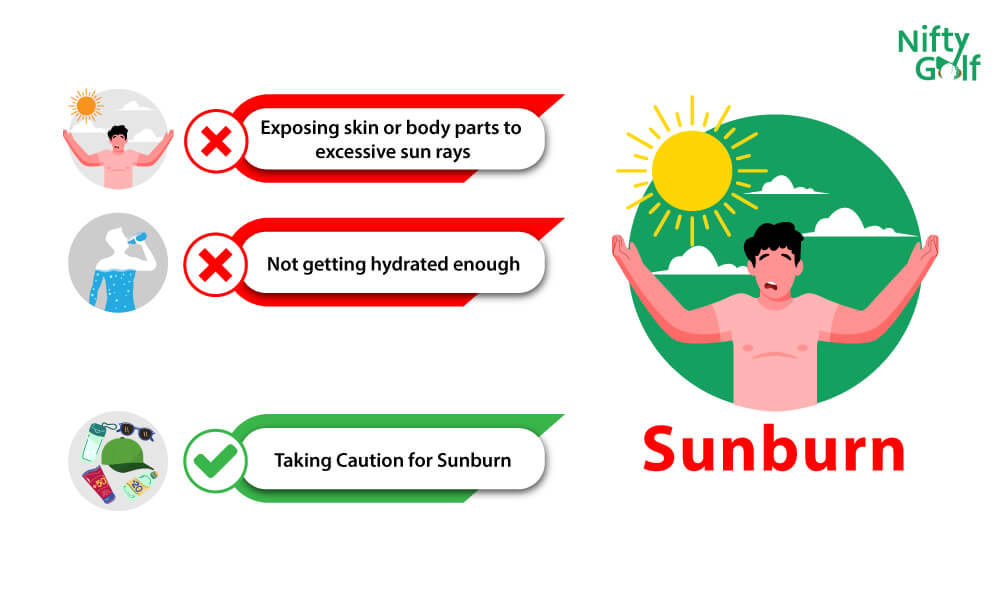
Sunburn is something often neglected by amateur golf players. But the impact of sunburn can be serious for the body and skin. None should take the risk as the skin is not only the largest organ in the human body but also covers the whole body. Exposing yourself to direct sun rays for even a little time can damage the skin tissue and make a player go dehydrated.
Prevention: Taking sunburn seriously is the first step to preventing it. You can use sunscreen, wear sunglass, hats, and full sleeve clothing to protect your skin. Another great way to save yourself from sunburn can be using an ideal golf simulator.
7. Shoulder Pain from Golf
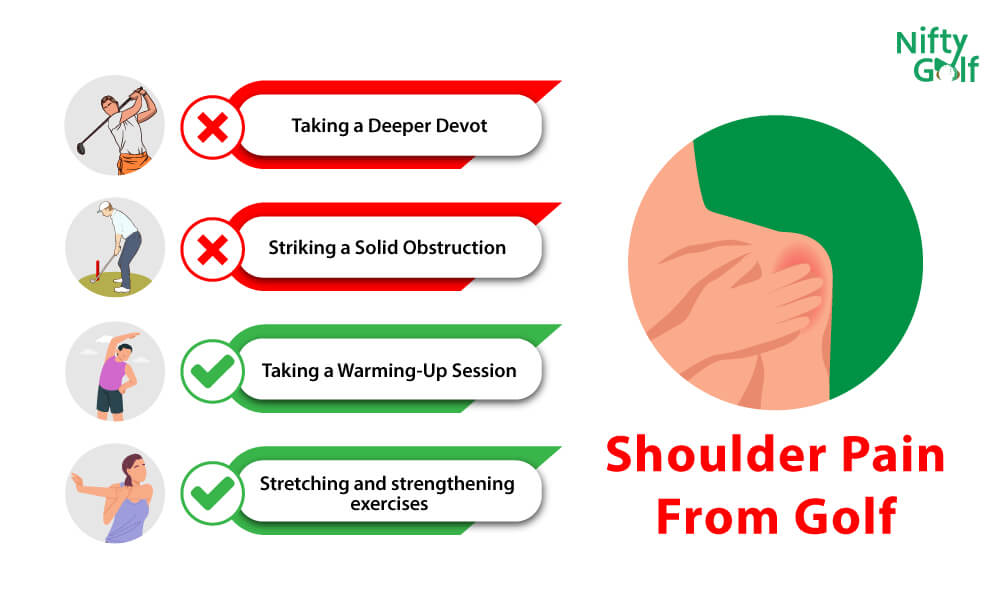
Any rotator cuff injury can cause shoulder and neck pain. Neck pain from golf is also a common golf injury. You can often suffer shoulder or neck pain due to highly aggressive swings, taking a deeper divot, or striking a solid obstruction on the ground. Even overplay or excessive playing can also trigger shoulder pain.
Shoulder pain can be a symptom of having a should tendinitis, bursitis, or even a torn rotator cuff.
Prevention: Like most other sport-related injuries, shoulder or neck injury is avoidable with a regular warmup session. Stretching and strengthening exercises can be helpful for you to keep such pains away.
How to Continue Playing Golf with an Injury
One general warning should start this section. Players with extreme injuries should not continue playing without the consent of a professional medical advisor. Golf is not a game that requires extreme physical labor. That’s why golfers often neglect injuries like pain and discomfort.
For most golfers, it’s easy to get to the golfing range and start swinging the ball away. They can effortlessly make nearly a hundred swings without any prior warmup session. Another key fact is that golf is a game of the elite class which means successful people. They occasionally play when they can get time out of their main hustle. Hence, they end up playing several rounds within a very short period. Eventually, they forget about injuries or don’t take them seriously.
Having said all this, an injury can threaten a golfer’s health. Without taking proper precautions or treatment, a severe injury can hamper his daily life. That’s why the first piece of advice to deal with an injury is to get a good check-up from a medical professional. If the issue is minor, the golfer can continue playing by taking the below measurements:
- Warming up and exercising a few guided movements to mitigate the pain of the injury.
- Taking a good rest, drinking enough water, and avoiding sunlight will provide the needed relaxation and energy to swing again.
- Again, taking some time to relax is essential as it eliminates the lactic acid accumulated in the body during playtime. Accumulation of lactic acid causes discomfort and weariness in the muscles.
- Focusing on the swing technique is your next step to reduce pain and prevent further loss. A player must make controlled and smooth swings to continue with an injury. You shouldn’t hit the ball with all your energy and put extra pressure on your back.
- Keeping proper balance is another key step a wounded payer should focus on. To ensure that you are keeping the best possible balance, you can bend your knees and place your feet about shoulder-width apart.
- You should control and measure hip rotation and weight distribution. Any forceful or hard turn can worsen your condition.
During his 2021 PGA Tour, Tyler McCumber showed the world how to play and score the highest with a smashed finger. He smashed his finger accidentally under his sliding window door. He underwent immediate surgery, and the finger was tied with a thick bandage. But all this couldn’t stop McCumber from playing.
Though his wound didn’t occur on the field, however, his unyielded attitude and winning is an example. It shows that you can continue playing with an injury following the proper technique.
Don’t let golf injuries ruin your game! (Share this article on Twitter)
Conclusion
A well-known fact about golf injuries is that golfers often take them lightly. They only come to know the severity of these injuries once they fall under one. Though some tricks help golfers continue playing with injuries, nothing good ever comes out of them. The best way to deal with common golf injuries is to take prior caution. You should hydrate yourself properly, take care of the sunrays, and warm your body up with proper exercises. Consulting with a professional physio will also be helpful.

